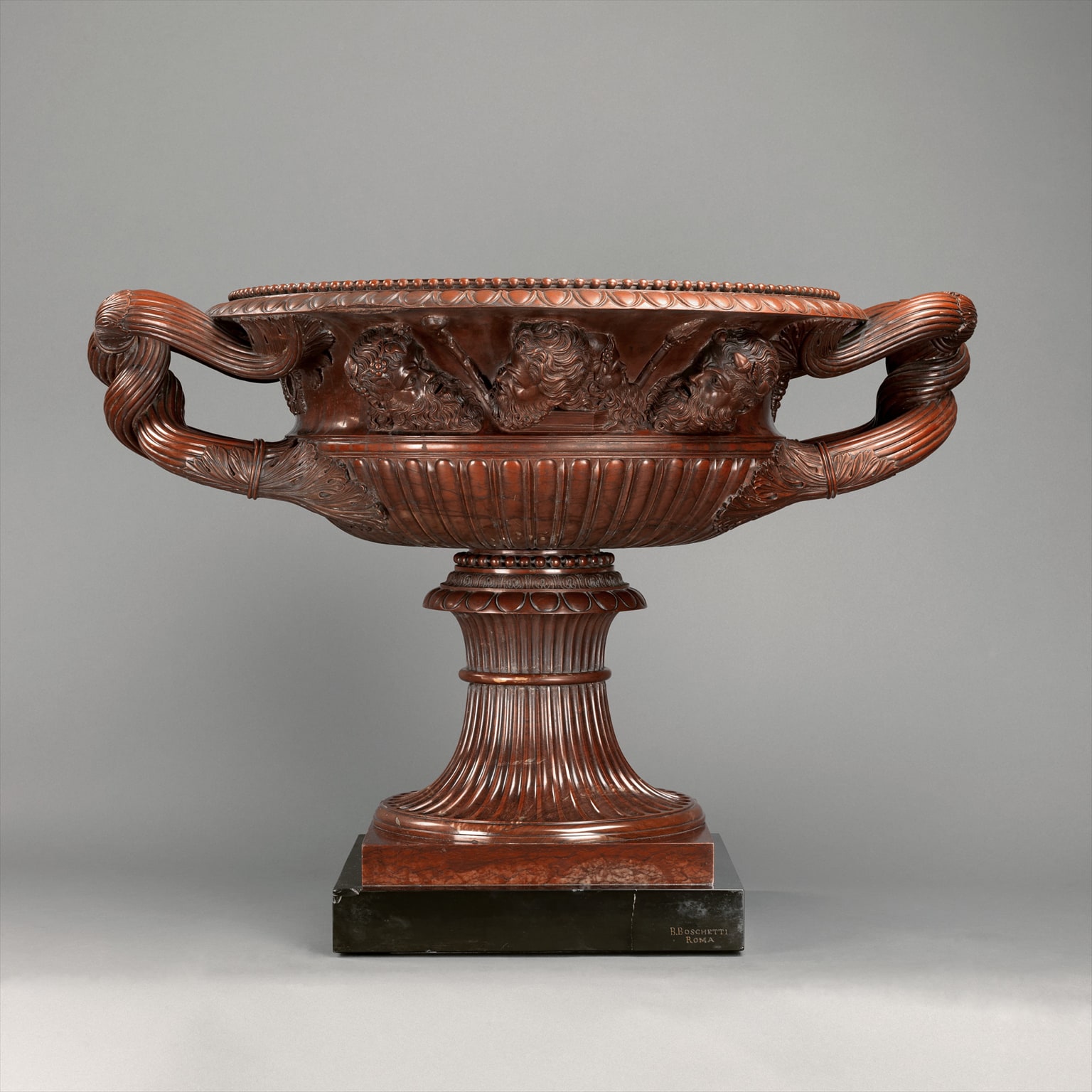Benedetto Boschetti
A ‘Grand Tour’ Carved Marmo Rosso Two Handled Model of the Warwick Vase
£280,000
Dimensions
Height: 59 cm (24 in)Width: 83 cm (33 in)
Depth: 63 cm (25 in)
Description
A ‘Grand Tour’ Carved Marmo Rosso Two Handled Model of the Warwick Vase, by Benedetto Boschetti. Italian, Circa 1830.
Signed ‘B. Boschetti Roma’ for the nineteenth century Italian sculptor Benedetto Boschetti.
This incredible and technically complex Marmo Rosso model of the Warwick Vase, is over 60 cm high but unusually carved from just a single block of marble on a scale rarely found, and created with unrivalled intricacy.
The only other known marble reduction of the Warwick Vase by this artist, now resides in the collection of the Toledo Museum, Ohio – for many years it was believed the Toledo vase was the only example carved on this scale by Boschetti.

The related ‘Warwick Vase’ signed ‘B. Boschetti fece’ in the Toledo Museum, Ohio (1969.87 A-B).
The vase is modelled after the antique vase found at the Roman Emperor Hadrian’s villa (Villa Adriana) in 1770 and subsequently in the collection of the Earl of Warwick. Perhaps the most famous object of antiquity on display in the nineteenth century, its fame became universal, not just in Britain, but across Europe, with even the Emperor Napoléon coveting it: ‘Had the Emperor Bonaparte been successful in conquering England…the first note in his pocket-book was to possess himself of the marble vase at Warwick’ (Baron Denon).
The vase found in 1770 was in fragments and was reconstructed by Sir William Hamilton at great expense. The credit for the reconstruction of the vase is usually given to the celebrated architect Giovanni Battista Piranesi. The likelihood however is that it was a collaborative process involving the antiquities dealer James Byres and the sculptor Bartolomeo Cavaceppi. Around the circumference of the vase are carved heads representing satyrs, except for one, which is of a female traditionally said to be a substitute for a missing head never recovered from Lake Tivoli. Piranesi designed the female mask was after one of his own designs for a pair of candelabra. A legend has grown up that this mask was carved in the likeness of Lady Hamilton and that as a result of a quarrel with the carver, the female mask was given a fawn’s ear.

A marble vase (“The Warwick vase”). Etching by Piranesi, circa 1770.
After the restoration was completed George Greville, 2nd Earl of Warwick, purchased the vase and displayed it at Warwick Castle. Because of its popularity the Earl banned full-scale reproductions of the vase in 1813, and only four full-size examples were ever made. The vase however had already come to embody the ideal of classical art, and Piranesi’s etchings were employed to make smaller reductions. Very few reductions of the quality and scale of the present example by Boschetti.
This reduction of the Warwick Vase, carved from a single block of marble uniquely captures the cultural importance of The Grand Tour, the obsession of the period with antiquity and classical sources, all revealed in the incredible skill and ambition of the marble carvers’ art.
Italy, Circa 1830.
Date
Circa, 1830
Origin
Italy
Medium
Marble
Signature
Signed 'B. Boschetti Roma'.
Founded in 1864 in Troyes as Bresson-Vachette, named after its founders, the company became Vachette Frères in 1865 and rapidly became one of the leading French locksmiths of the second half of the 19th century. With a commercial office in Paris and workshops in Troyes, and from 1870 in Sailly-Flibeaucourt; Vachette supplied locks to many of the most important Parisian ébénistes of the period. Their locks from this time are marked with their famous stamp of ‘V.F’ and ‘Paris’ above crossed keys and can be found on some of the most important furniture created at the end of the 19th century.
Today, the mark ‚‘Vachette‚’ still exists as a subsidiary of STREMLER/JPM and LAPERCHE, under the holding of the Swedish group ASSA ABLOY.
Meyer, Jonathan, ‘Great Exhibitions – London, New York, Paris, Philadelphia, 1851-1900′, Antique Collectors’ Club, (Woodbridge, UK), 2006; p. 41.
Alvar Gonzalez-Palacios, ‘Il Tempo del Gusto’, (Milan), 1986; p.120 and fig. 5-7.











 Print
Print


